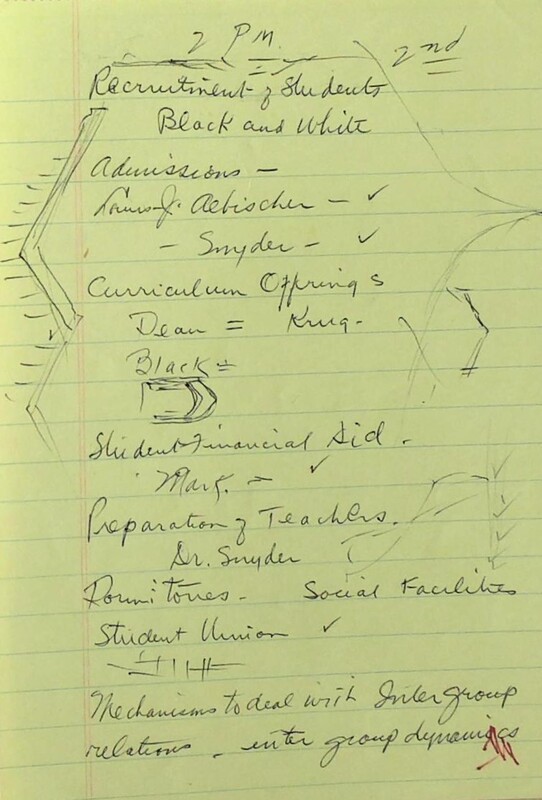Constructed Forgetfulness
The glare of civil rights investigations during the late 1960s and early 1970s hardly seemed to phase GMC Dean Robert C. Krug. Krug summed up the federal and state scrutiny in 1971 as an “interesting" period producing "flack in the papers and on the positive side…substantial progress . . . in strengthening academic programs.”[1] With the George Mason College Advisory Committee in damage control, the Virginia State Advisory Committee continued to press Chancellor Thompson and his supervisor, University of Virginia President Edgar Shannon, to change racial dynamics on campus.
The George Mason College Advisory Committee was concerned that UVA President Shannon was going out of his way to please civil rights advocates. Advisory Committee member Harrison Mann wrote UVA Rector Joseph McConnell to warn that Shannon had been “spongy in dealing with this kind of thing” and was overly “conciliatory with the Fairfax Human Relations Council." Mann wanted Shannon to stop "trying to placate and say no.”[2]
Advisory Committee Chairman John Wood went one step further. He asked Shannon to end contact with the VSAC. More meetings would only serve as a “spring-board for . . . publicity,” Wood cautioned, and entrap GMC administrators in "statements" that the VSAC could "use subsequently.” Shannon agreed with the Advisory Committee "that it would be in the best interest of George Mason College” for him not to meet with investigators.[3]
Shannon’s decision to end cooperation with the VSAC relieved GMC legal counsel A. Hugo Blankingship who recommended that “no useful purpose can be served by involving the college any further in this unfortunate matter." Henceforth, the GMC Advisory Committee adopted a business-as-usual attitude.[4]
At the start of 1971-1972 academic year, college administrators felt they were “in the clear." By October, Chancellor Thompson had distributed a prepared Q&A sheet to Northern Virginia candidates for the Virginia General Assembly. The document responded to hypothetical questions a legislator might have concerning the college, such as budgetary appropriations and GMC's “leadership role in the community." Thompson made it clear that his institution “cannot become a community social service station. George Mason College cannot bend in the wind with every demand for change which sweeps across . . . the state or the nation.” Instead, he envisioned “mov[ing] ahead very firmly in those areas . . . [that] make a strong and worthwhile contribution.”[5]
GMC began to admit more Black students and hire several Black admissions officers as the 1970s progressed. For example, Andrew Evans was brought on as the first minority recruiter in 1974.[6] And yet one is left to wonder how much more could have been done had George Mason College from the start prioritized Black admissions. Perhaps administrators would have responded with humility, rather than hostility, when confronted by civil rights advocates. Perhaps administrators would have taken this issue more seriously as opposed to drawing doodles of speedboats atop their notepads documenting HEW probes in 1969. Perhaps prolonged investigations could have been avoided if Thompson had headed GMC faculty member Mark Tannenbaum's 1969 encouragement to "lead the effort" to correct "lacking" Black enrollment "rather than waiting for dissent to occur."[7]
The George Mason College Advisory Committee was instrumental in constructing GMC's vision of an independent institution of higher learning. In 1978, George Mason President George W. Johnson called Harrison's Mann’s portrait “grac[ing] my office" an image of "dreams for the University.”[8] GMC administrators guided the college to incredible institutional growth while also resisting efforts to end racial exclusivity at the school. When today's students enter Thompson Hall on the Fairfax Campus, should they consider if Thompson’s vision for a “strong” university would have barred them at the door?
By Anthony Guidone
[1] George Mason College Advisory Board, Meeting Minutes 11 May 1971, John C. Wood Papers, Box 1, Folder 2, Special Collections Research Center, University Libraries, George Mason University.
[2] Harrison Mann to Joseph McConnell, 27 July 1971, John C. Wood Papers, Box 1, Folder 2, Special Collections Research Center, University Libraries, George Mason University.
[3] John C. Wood to Edgar F. Shannon, 23 July 1971, John C. Wood Papers, Box 1, Folder 2, Special Collections Research Center, University Libraries, George Mason University; Edgar F. Shannon to John C. Wood, 11 August 1971, Office of the President Records, Series 3, Box 14, Folder 8, Special Collections Research Center, University Libraries, George Mason University.
[4] A. Hugo Blankingship to Lorin A. Thompson, 23 April 1971, John C. Wood Papers, Box 1, Folder 3, Special Collections Research Center, University Libraries, George Mason University.
[5] George Mason College Advisory Committee Meeting Minutes, 9 February 1971, John C. Wood Papers, Box 1, Folder 3, Special Collections Research Center, University Libraries, George Mason University.
[6] Broadside vol. 15, no. 1, September 3, 1974, Special Collections Research Center, University Libraries, George Mason University; Misha Griffith and Robert Vay, “Andrew Evans Oral History Interview Segment,” George Mason University Oral History Program, accessed August 5, 2021, http://oralhistory.gmu.edu/items/show/4.
[7] Mark Tannenbaum to Lorin A. Thompson, 25 September 1969, Office of the President Records, Series 3, Box 13, Folder 5, Special Collections Research Center, University Libraries, George Mason University.
[8] George W. Johnson to Mrs. Harrison Mann, 18 July 1978 [draft], Office of the President Records, Series 3, Box 2, Folder 8, Special Collections Research Center, University Libraries, George Mason University. Mann’s contributions to GMC were undoubtedly many, including sponsoring the 1954 resolution in the Virginia Assembly which led to the creation of George Mason College. However, the story of how Mann and other GMC administrators slowed progress in race relations at GMC must be considered alongside stories of their institution-building. This reexamination creates a more holistic understanding of their impact upon campus.


